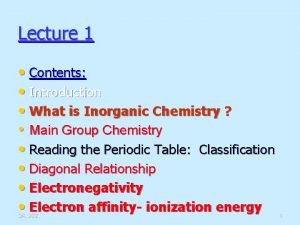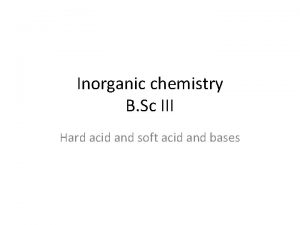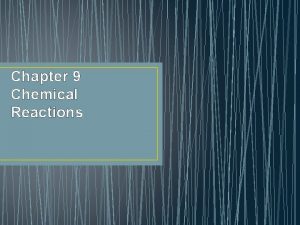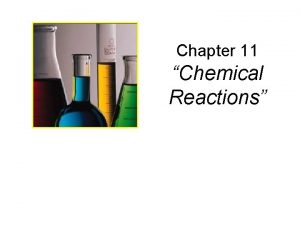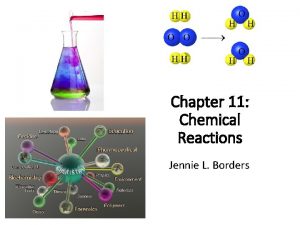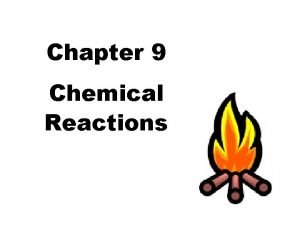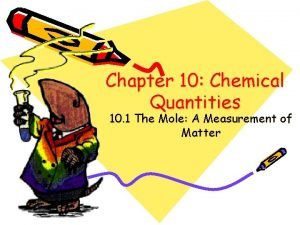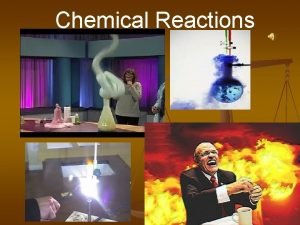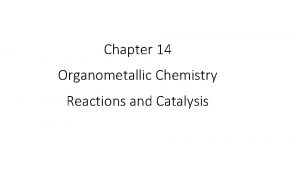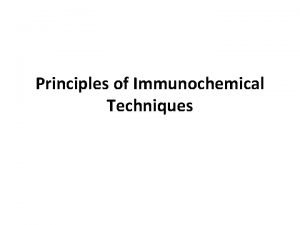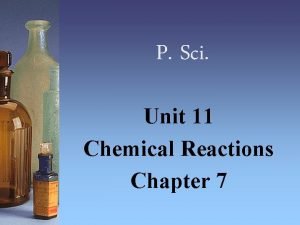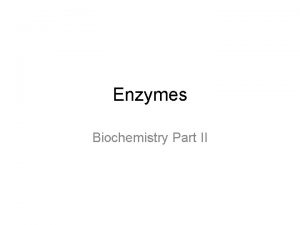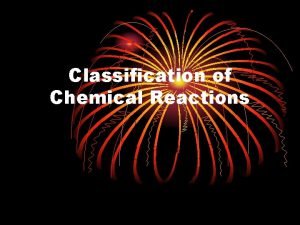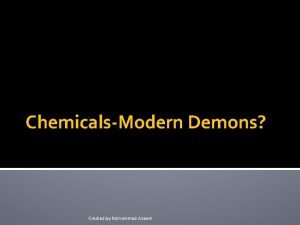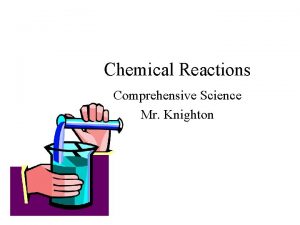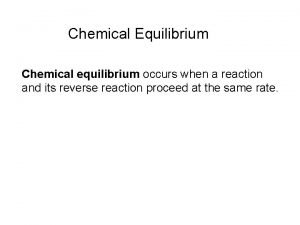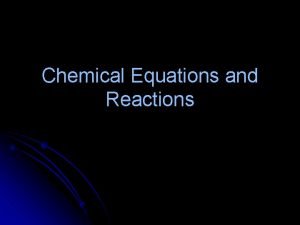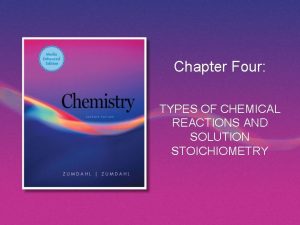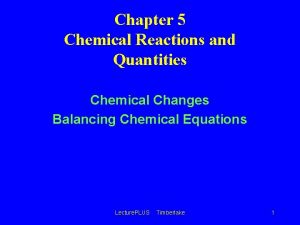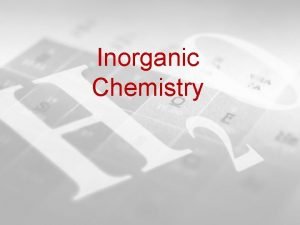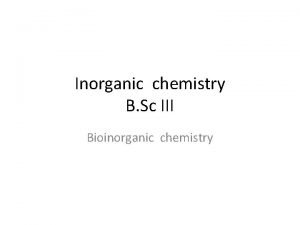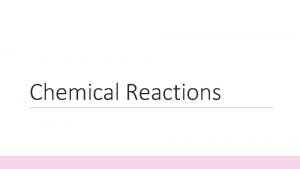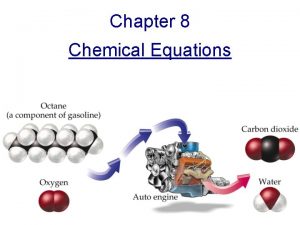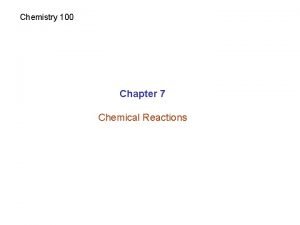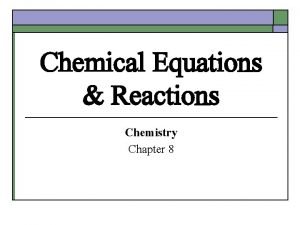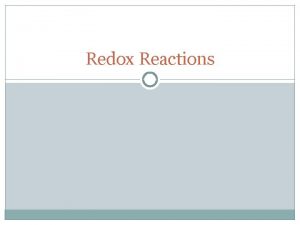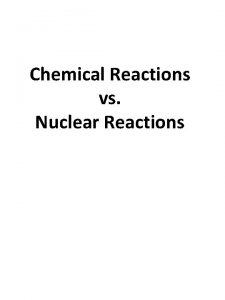Chapter 9 Chemical Reactions Introduction to Inorganic Chemistry
































































- Slides: 64

Chapter 9. Chemical Reactions Introduction to Inorganic Chemistry Instructor Dr. Upali Siriwardane (Ph. D. Ohio State) E-mail: upali@latech. edu Office: 311 Carson Taylor Hall ; Phone: 318 -257 -4941; Office Hours: MWF 8: 00 -9: 00 and 11: 00 -12: 00; TR 10: 00 -12: 00 Contact me trough phone or e-mail if you have questions Online Tests on Following days March 24, 2017: Test 1 (Chapters 1 -3) April 10, 2017 : Test 2 (Chapters 4 -5) May 1, 2017: Test 3 (Chapters 6, 7 &8) May 12, 2017 : Test 4 (Chapters 9, 10 &11) May 15, 2017: Make Up Exam: Chapters 1 -11).

Chapter 9 Table of Contents 9. 1 9. 2 9. 3 9. 4 9. 5 9. 6 9. 7 9. 8 9. 9 Types of Chemical Reactions Redox and Nonredox Chemical Reactions Terminology Associated with Redox Processes Collision Theory and Chemical Reactions Exothermic and Endothermic Chemical Reactions Factors That Influence Chemical Reaction Rates Chemical Equilibrium Constants Altering Equilibrium Conditions: Le Châtelier’s Principle Copyright © Cengage Learning. All rights reserved 2

Section 9. 1 Types of Chemical Reactions Chemical Reaction • Process in which at least one new substance is produced as a result of chemical change. • Major types of chemical reactions – Combination – Decomposition – Displacement (single) – Exchange (double) – Combustion Copyright © Cengage Learning. All rights reserved 3

Section 9. 2 Redox and Nonredox Reactions • Oxidation-Reduction (Redox) Reaction – A chemical reaction in which there is a transfer of electrons from one reactant to another reactant. • Nonoxidation-Reduction (Nonredox) Reaction – A chemical reaction in which there is no transfer of electrons from one reactant to another reactant. Copyright © Cengage Learning. All rights reserved 4

Section 9. 1 Types of Chemical Reactions Combination Reaction • A chemical reaction in which a single product is produced from two (or more) reactants. X + Y → XY (redox) 2 H 2 + O 2 → 2 H 2 O Copyright © Cengage Learning. All rights reserved 5

Section 9. 1 Types of Chemical Reactions Decomposition Reaction • A chemical reaction in which a single reactant is converted into two (or more) simpler substances (elements or compounds). XY → X + Y (redox) 2 H 2 O → 2 H 2 + O 2 Copyright © Cengage Learning. All rights reserved 6

Section 9. 1 Types of Chemical Reactions Displacement Reaction • A chemical reaction in which an atom or molecule displaces an atom or group of atoms from a compound. X + YZ → Y + XZ (redox) Zn + 2 HCl → Zn. Cl 2 + H 2 Copyright © Cengage Learning. All rights reserved 7

Section 9. 1 Types of Chemical Reactions Exchange Reaction (double displacement) • A chemical reaction in which two substances exchange parts with another and form two different substances. AX + BY → AY + BX (non-redox) Na 2 SO 4(aq) + Pb(NO 3)2(aq) → 2 Na. NO 3(aq) + Pb. SO 4(s) Copyright © Cengage Learning. All rights reserved 8

Section 9. 1 Types of Chemical Reactions Combustion Reaction • A chemical reaction between a substance and oxygen (usually from air) that proceeds with the evolution of heat and light (usually from a flame). C 3 H 8 + 5 O 2 → 3 CO 2 + 4 H 2 O (redox) Copyright © Cengage Learning. All rights reserved 9

Section 9. 1 Types of Chemical Reactions Concept Check Classify each of the following chemical reactions as a combination, decomposition, displacement, exchange, or combustion reaction. a) Mg(s) + 2 HCl(aq) → Mg. Cl 2(aq) + H 2(g) b) HCl(g) + NH 3(g) → NH 4 Cl(s) c) 4 NH 3 + 5 O 2 → 4 NO + 6 H 2 O Copyright © Cengage Learning. All rights reserved 10

Section 9. 1 Types of Chemical Reactions Concept Check Classify each of the following chemical reactions as a combination, decomposition, displacement, exchange, or combustion reaction. a) Mg(s) + 2 HCl(aq) → Mg. Cl 2(aq) + H 2(g) displacement b) HCl(g) + NH 3(g) → NH 4 Cl(s) combination c) 4 NH 3 + 5 O 2 → 4 NO + 6 H 2 O combustion Copyright © Cengage Learning. All rights reserved 11

Section 9. 2 Redox and Nonredox Reactions Oxidation Number (Oxidation State)of an Element • A number that represents the charge that an atom appears to have when the electrons in each covalent/ionic bond it is participating in are assigned to the more electronegative of the two atoms involved in the bond. E. g. Na. Cl made up of Na+ and Cl. H 2 O has Copyright © Cengage Learning. All rights reserved 1+ 2 - 1+ H-O-H 12

Section 9. 2 Redox and Nonredox Reactions Rules for Assigning Oxidation Numbers 1. Oxidation # of an element in its elemental state = 0. 2. Oxidation # of a monatomic ion = charge on ion. 3. Group 1 A = +1; Group IIA = +2. 4. Hydrogen = +1 in covalent compounds. 5. Oxygen = 2 in covalent compounds (except in peroxides where it = 1). 6. In binary molecular compounds, the more electronegative element is assigned a negative oxidation # equal to its 1+ 2 - 1+ charge in binary ionic compounds. H O H 7. Sum of oxidation states = 0 in compounds; 8. Sum of oxidation states of an ion = charge of the ion. Copyright © Cengage Learning. All rights reserved 13

Section 9. 2 Redox and Nonredox Reactions Exercise Find the oxidation numbers for each of the elements in each of the following compounds: • • • K 2 Cr 2 O 7 CO 32 Mn. O 2 PCl 5 SF 4 Copyright © Cengage Learning. All rights reserved 14

Section 9. 2 Redox and Nonredox Reactions Exercise Find the oxidation numbers for each of the elements in each of the following compounds: • • • K 2 Cr 2 O 7 CO 32 Mn. O 2 PCl 5 SF 4 Copyright © Cengage Learning. All rights reserved K = +1; Cr = +6; O = – 2 C = +4; O = – 2 Mn = +4; O = – 2 P = +5; Cl = – 1 S = +4; F = – 1 15

Section 9. 2 Redox and Nonredox Reactions • To determine whether a reaction is a redox reaction or a nonredox reaction, look for changes in the oxidation # of elements involved in the reaction. • Changes in oxidation # mean a transfer of electrons = redox reaction. Copyright © Cengage Learning. All rights reserved 16

Section 9. 2 Redox and Nonredox Reactions Reaction Between Calcium Metal and Chlorine Gas Ca + Cl 2 → Ca. Cl 2 0 Copyright © Cengage Learning. All rights reserved 0 +2 – 1 17

Section 9. 3 Terminology Associated with Redox Processes Redox Characteristics • In a redox reaction, one reactant undergoes oxidation, and another reactant undergoes reduction. • Oxidation – a reactant loses one or more electrons; reducing agent. • Reduction – a reactant gains one or more electrons; oxidizing agent. Copyright © Cengage Learning. All rights reserved 18

Section 9. 3 Terminology Associated with Redox Processes Copyright © Cengage Learning. All rights reserved 19

Section 9. 3 Terminology Associated with Redox Processes Copyright © Cengage Learning. All rights reserved 20

Section 9. 3 Terminology Associated with Redox Processes Concept Check Which of the following are oxidation-reduction reactions? Identify the oxidizing agent and the reducing agent. a) Zn(s) + 2 HCl(aq) Zn. Cl 2(aq) + H 2(g) b) Cr 2 O 72 -(aq) + 2 OH-(aq) 2 Cr. O 42 -(aq) + H 2 O(l) c) 2 Cu. Cl(aq) Cu. Cl 2(aq) + Cu(s) Copyright © Cengage Learning. All rights reserved 21

Section 9. 3 Terminology Associated with Redox Processes Concept Check Which of the following are oxidation-reduction reactions? Identify the oxidizing agent and the reducing agent. a) Zn(s) + 2 HCl(aq) Zn. Cl 2(aq) + H 2(g) b) Cr 2 O 72 -(aq) + 2 OH-(aq) 2 Cr. O 42 -(aq) + H 2 O(l) c) 2 Cu. Cl(aq) Cu. Cl 2(aq) + Cu(s) a) Zn – reducing agent; HCl – oxidizing agent c) Cu. Cl acts as the reducing and oxidizing agent. Copyright © Cengage Learning. All rights reserved 22

Section 9. 4 Collision Theory and Chemical Reactions Collision Theory • Molecular Collisions • Activation Energy • Collision Orientation Copyright © Cengage Learning. All rights reserved 23

Section 9. 4 Collision Theory and Chemical Reactions Molecular Collisions • The reactant molecules, ions, or atoms must come in contact (collide) with one another in order for any chemical change to occur. Copyright © Cengage Learning. All rights reserved 24

Section 9. 4 Collision Theory and Chemical Reactions Activation Energy • Minimum combined kinetic energy that colliding reactant particles must possess in order for their collision to result in a chemical reaction. Copyright © Cengage Learning. All rights reserved 25

Section 9. 4 Collision Theory and Chemical Reactions Collision Orientation • Reaction rates are sometimes very slow because reactant molecules must be orientated in a certain way in order for collisions to lead successfully to products. Copyright © Cengage Learning. All rights reserved 26

Section 9. 4 Collision Theory and Chemical Reactions Reaction of NO 2 and CO to Produce NO and CO 2 Copyright © Cengage Learning. All rights reserved 27

Section 9. 5 Exothermic and Endothermic Chemical Reactions Exothermic Reaction • A chemical reaction in which energy is released as the reaction occurs. • Energy is a “product” of the chemical reaction. § Example – burning of a fuel Copyright © Cengage Learning. All rights reserved 28

Section 9. 5 Exothermic and Endothermic Chemical Reactions Exothermic Reaction • Occurs when the energy required to break bonds in the reactants is less than the energy released by bond formation in the products. Copyright © Cengage Learning. All rights reserved 29

Section 9. 5 Exothermic and Endothermic Chemical Reactions Exothermic Reaction Copyright © Cengage Learning. All rights reserved 30

Section 9. 5 Exothermic and Endothermic Chemical Reactions Endothermic Reaction • A chemical reaction in which a continuous input of energy is needed for the reaction to occur. • Energy is a “reactant” of the chemical reaction. § Example – photosynthesis in plants Copyright © Cengage Learning. All rights reserved 31

Section 9. 5 Exothermic and Endothermic Chemical Reactions Endothermic Reaction • Occurs when the energy required to break bonds in the reactants is more than the energy released by bond formation in the products. • Additional energy must be supplied from external sources as the reaction proceeds. Copyright © Cengage Learning. All rights reserved 32

Section 9. 5 Exothermic and Endothermic Chemical Reactions Endothermic Reaction Copyright © Cengage Learning. All rights reserved 33

Section 9. 6 Factors That Influence Chemical Reaction Rates Chemical Reaction Rate • The rate at which reactants are consumed or products produced in a given time period in a chemical reaction. Copyright © Cengage Learning. All rights reserved 34

Section 9. 6 Factors That Influence Chemical Reaction Rates Four Factors That Affect Reaction Rate 1. Physical nature of the reactants 2. Reactant concentrations 3. Reaction temperature 4. Presence of catalysts Copyright © Cengage Learning. All rights reserved 35

Section 9. 6 Factors That Influence Chemical Reaction Rates Physical Nature of Reactants • Includes the physical state of each reactant (s, l, or g) and the particle size. • When reactants are all the same physical state, reaction rate is generally faster between liquid-state reactants than between solid-state reactants and is fastest between gaseous-state reactants. Copyright © Cengage Learning. All rights reserved 36

Section 9. 6 Factors That Influence Chemical Reaction Rates Physical Nature of Reactants • For reactants in the solid state, reaction rate increases as subdivision of the solid increases. • When the particle size of a solid is extremely small, reaction rates can be so fast than an explosion results. Copyright © Cengage Learning. All rights reserved 37

Section 9. 6 Factors That Influence Chemical Reaction Rates Reactant Concentrations • An increase in the concentration of a reactant causes an increase in the rate of the reaction. • There are molecules of that reactant present in the reaction mixture; thus collisions between this reactant and other reactant particles are more likely. Copyright © Cengage Learning. All rights reserved 38

Section 9. 6 Factors That Influence Chemical Reaction Rates Reaction Temperature • Reaction rate increases as the temperature of the reactants increases. • The increased molecular speed causes more collisions to take place in a given time. Copyright © Cengage Learning. All rights reserved 39

Section 9. 6 Factors That Influence Chemical Reaction Rates Presence of Catalysts • Catalyst – a substance that increases a chemical reaction rate without being consumed in the chemical reaction. • Increases reaction rates by providing alternative reaction pathways that have lower activation energies than the original, uncatalyzed pathway. • Enzymes are the catalysts in the human body. Copyright © Cengage Learning. All rights reserved 40

Section 9. 6 Factors That Influence Chemical Reaction Rates Presence of Catalysts Copyright © Cengage Learning. All rights reserved 41

Section 9. 7 Chemical Equilibrium • The state in which forward and reverse chemical reactions occur simultaneously at the same rate. • The concentrations of reactants and products no longer change (but do not have to be equal). • On the molecular level, there is frantic activity. Equilibrium is not static, but is a highly dynamic situation. Copyright © Cengage Learning. All rights reserved 42

Section 9. 7 Chemical Equilibrium H 2 + I 2 2 HI Copyright © Cengage Learning. All rights reserved 43

Section 9. 7 Chemical Equilibrium H 2 + I 2 2 HI Copyright © Cengage Learning. All rights reserved 44

Section 9. 7 Chemical Equilibrium Reversible Reaction • A chemical reaction in which the conversion of reactants to products (the forward reaction) and the conversion of products to reactants (the reverse reaction) occur at the same time. • All reactions are reversible (can go in either direction). Copyright © Cengage Learning. All rights reserved 45

Section 9. 7 Chemical Equilibrium Concept Check Consider an equilibrium mixture in a closed vessel reacting according to the equation: H 2 O(g) + CO(g) H 2(g) + CO 2(g) You add more H 2 O to the flask. How does the concentration of each chemical compare to its original concentration after equilibrium is reestablished? Justify your answer. Copyright © Cengage Learning. All rights reserved 46

Section 9. 7 Chemical Equilibrium Concept Check Consider an equilibrium mixture in a closed vessel reacting according to the equation: H 2 O(g) + CO(g) H 2(g) + CO 2(g) You add more H 2 to the flask. How does the concentration of each chemical compare to its original concentration after equilibrium is reestablished? Justify your answer. Copyright © Cengage Learning. All rights reserved 47

Section 9. 8 Equilibrium Constants Equilibrium Constant • A numerical value that characterizes the relationship between the concentrations of reactants and products in a system at chemical equilibrium. Copyright © Cengage Learning. All rights reserved 48

Section 9. 8 Equilibrium Constants w. A + x. B y. C + z. D y z [C] [D] Keq= w x [A] [B] Copyright © Cengage Learning. All rights reserved 49

Section 9. 8 Equilibrium Constants Conclusions About the Equilibrium Expression • Square brackets refer to molar concentrations. • Product concentrations are always placed in the numerator. • Reactant concentrations are always placed in the denominator. • The coefficients in the balanced chemical equation determine the powers to which the concentrations are raised. • Keq is used to denote an equilibrium constant. Copyright © Cengage Learning. All rights reserved 50

Section 9. 8 Equilibrium Constants Conclusions About the Equilibrium Expression • Only concentrations of gases and substances in solution are written in an equilibrium expression. • The concentrations of pure liquids and pure solids, which are constants, are never included in an equilibrium expression. Copyright © Cengage Learning. All rights reserved 51

Section 9. 8 Equilibrium Constants Temperature Dependence • Keq always has the same value at a given temperature regardless of the amounts of reactants or products that are present initially. • If the temperature changes, the value of Keq also changes. • For reactions where the forward reaction is exothermic, Keq decreases with increasing T. • For reactions where the forward reaction is endothermic, Keq increases with increasing T. Copyright © Cengage Learning. All rights reserved 52

Section 9. 8 Equilibrium Constants Reaction Completeness • If Keq is large, the equilibrium system contains more products than reactants. • If Keq is small, the equilibrium system contains more reactants than products. Copyright © Cengage Learning. All rights reserved 53

Section 9. 8 Equilibrium Constants Equilibrium Position • Qualitative indication of the relative amounts of reactants and products present when a chemical reaction reaches equilibrium. Copyright © Cengage Learning. All rights reserved 54

Section 9. 8 Equilibrium Constants Keq and the Extent to Which a Chemical Reaction Has Taken Place Copyright © Cengage Learning. All rights reserved 55

Section 9. 9 Altering Equilibrium Conditions: Le Châtelier’s Principle • If a stress is applied to a system in equilibrium, the system will readjust in the direction that best reduces the stress imposed on the system. • If more products have been produced as a result of the disruption, the equilibrium is said to have shifted to the right. • When disruption causes more reactants to form, the equilibrium has shifted to the left. Copyright © Cengage Learning. All rights reserved 56

Section 9. 9 Altering Equilibrium Conditions: Le Châtelier’s Principle Effects of Changes on the System 1. Concentration Changes: The system will shift away from the added component. If a component is removed, the opposite effect occurs. Copyright © Cengage Learning. All rights reserved 57

Section 9. 9 Altering Equilibrium Conditions: Le Châtelier’s Principle Concentration Changes Copyright © Cengage Learning. All rights reserved 58

Section 9. 9 Altering Equilibrium Conditions: Le Châtelier’s Principle Effects of Changes on the System 2. Temperature: Keq will change depending upon the temperature (endothermic – energy is a reactant; exothermic – energy is a product). Copyright © Cengage Learning. All rights reserved 59

Section 9. 9 Altering Equilibrium Conditions: Le Châtelier’s Principle Effect of Temperature Change on an Equilibrium Mixture Copyright © Cengage Learning. All rights reserved 60

Section 9. 9 Altering Equilibrium Conditions: Le Châtelier’s Principle Effects of Changes on the System 3. Pressure: a) The system will shift away from the added gaseous component. If a component is removed, the opposite effect occurs. b) Addition of inert gas does not affect the equilibrium position. c) Decreasing the volume shifts the equilibrium toward the side with fewer moles of gas. Copyright © Cengage Learning. All rights reserved 61

Section 9. 9 Altering Equilibrium Conditions: Le Châtelier’s Principle Effects of Changes on the System 4. Addition of Catalysts: Do not change the position of an equilibrium; although equilibrium is established more quickly. Copyright © Cengage Learning. All rights reserved 62

Section 9. 9 Altering Equilibrium Conditions: Le Châtelier’s Principle To play movie you must be in Slide Show Mode PC Users: Please wait for content to load, then click to play Mac Users: CLICK HERE Copyright © Cengage Learning. All rights reserved 63

Section 9. 9 Altering Equilibrium Conditions: Le Châtelier’s Principle Equilibrium Decomposition of N 2 O 5 To play movie you must be in Slide Show Mode PC Users: Please wait for content to load, then click to play Mac Users: CLICK HERE Copyright © Cengage Learning. All rights reserved 64
 Section 2 reinforcement classifying chemical reactions
Section 2 reinforcement classifying chemical reactions Chemical reactions section 2 classifying chemical reactions
Chemical reactions section 2 classifying chemical reactions Inorganic chemistry vs organic chemistry
Inorganic chemistry vs organic chemistry Chapter 8 review chemical equations and reactions section 2
Chapter 8 review chemical equations and reactions section 2 Chemistry unit 5 reactions balancing reactions worksheet
Chemistry unit 5 reactions balancing reactions worksheet Chapter 18 chemical reactions balancing chemical equations
Chapter 18 chemical reactions balancing chemical equations Types of reactions
Types of reactions Importance of pharmaceutical inorganic compound
Importance of pharmaceutical inorganic compound Introduction to inorganic chemistry
Introduction to inorganic chemistry Chemistry in biology section 2 chemical reactions
Chemistry in biology section 2 chemical reactions Chapter 6 section 1 atoms elements and compounds answer key
Chapter 6 section 1 atoms elements and compounds answer key Section 1 chemical changes
Section 1 chemical changes Chapter 10 chemical reactions answer key
Chapter 10 chemical reactions answer key Chapter 9 study guide chemical reactions
Chapter 9 study guide chemical reactions Advanced inorganic chemistry lecture notes
Advanced inorganic chemistry lecture notes Is ch4o organic or inorganic
Is ch4o organic or inorganic What is fajans rule
What is fajans rule Chapter 9 chemical reactions
Chapter 9 chemical reactions Chapter 9 study guide chemical reactions
Chapter 9 study guide chemical reactions Chapter 8 section 1 chemical equations and reactions
Chapter 8 section 1 chemical equations and reactions Balancing equations chapter 8
Balancing equations chapter 8 Chapter 11 chemical reactions answer key
Chapter 11 chemical reactions answer key Predict the products of the following reactions.
Predict the products of the following reactions. Chapter 19 chemical reactions answer key
Chapter 19 chemical reactions answer key What is the type of reaction
What is the type of reaction Chapter 9 chemical reactions
Chapter 9 chemical reactions Oxidation half reaction
Oxidation half reaction Chemistry chapter 9 chemical names and formulas
Chemistry chapter 9 chemical names and formulas Chemistry chapter 10 chemical quantities
Chemistry chapter 10 chemical quantities 4 types of chemical reactions
4 types of chemical reactions 5 types of reactions chemistry
5 types of reactions chemistry Type of reactions chemistry
Type of reactions chemistry Carbon reactants
Carbon reactants Slidetodoc.com
Slidetodoc.com Chapter 7 chemical formulas and chemical compounds test
Chapter 7 chemical formulas and chemical compounds test Chemical formulas and chemical compounds chapter 7
Chemical formulas and chemical compounds chapter 7 Proportional relationships in chemical reactions
Proportional relationships in chemical reactions Balancing chemical equations definition
Balancing chemical equations definition Different types of redox reactions
Different types of redox reactions Identify types of reactions
Identify types of reactions Chemical reaction types
Chemical reaction types Predicting products of chemical reactions
Predicting products of chemical reactions 4 types of chemical reactions
4 types of chemical reactions Non examples of chemical reactions
Non examples of chemical reactions The calculations of quantities in chemical reactions
The calculations of quantities in chemical reactions Principles of immuno chemical reactions
Principles of immuno chemical reactions Predicting products of chemical reactions
Predicting products of chemical reactions Synthesis reaction predicting products
Synthesis reaction predicting products Section 3 predicting the products of chemical reactions
Section 3 predicting the products of chemical reactions Unit 11 chemical reactions
Unit 11 chemical reactions Toxic reactions chemical equations lesson 68 answers
Toxic reactions chemical equations lesson 68 answers Four types of chemical reactions
Four types of chemical reactions What is the role of enzymes in chemical reactions
What is the role of enzymes in chemical reactions Describing chemical reactions
Describing chemical reactions Chemical reactions classification
Chemical reactions classification Chemical reactions in everyday life
Chemical reactions in everyday life Five chemical changes
Five chemical changes Reactants and products
Reactants and products 5 general types of chemical reactions
5 general types of chemical reactions Solubility rules
Solubility rules Equilibrium occurs when
Equilibrium occurs when What are the 4 types of chemical reactions
What are the 4 types of chemical reactions Four types of chemical reactions
Four types of chemical reactions 5 chemical reactions
5 chemical reactions Section 2-4 chemical reactions and enzymes
Section 2-4 chemical reactions and enzymes








